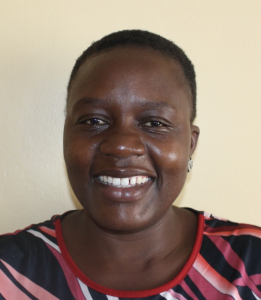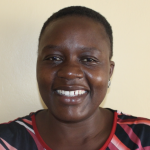Every morning around 7am, students of Kamuluguywa Secondary School walk through the school gate carrying their school bags. Boys and girls come through the gate in groups of threes and fours. First, the teacher on duty has them line up for a hygiene check. They make sure students are in full uniform with shirts tucked in and hair combed. Those with dirty school uniforms are sent to the school bathroom to wash up as their clean counterparts gather for daily announcements.
This secondary school currently has a student enrollment of 155. It employs 12 teachers and five support staff. This year, the overall school population has dropped by 30 students, and administration attributes this to their water shortage.
Water
After morning announcements, they start the first lesson. At break time, one class is tasked with going to the spring to fetch water for staff to cook lunch. Boys and girls are required to keep a brisk pace on the one-kilometer walk to the spring. An adult chaperone always trails behind the group. After lunch, they are again sent for the water needed for cleaning classrooms.
Though it's possible the water from this spring is clean because of the construction work that's been done on it, we're concerned about the long trip back as students carry the water in open containers. Either way, a lot of time and energy is sacrificed as students take their turns making the trip for water. By the time they return, they've already missed a lot of class.
Here is what one staff member has to say about the situation:
"My name is Lihanda Asega, and I am the deputy headteacher in this school. The walk for water and sanitation has not been easy. We have a small rainwater tank that is not sufficient, hence we have to send the pupils to Kamuluguywa Water Spring. Though the spring is protected, our learners waste a lot of time when sent to fetch water. It's especially worse when we send both boys and girls, as they go loitering in the market and never show up for afternoon classes. Three of our girls got pregnant last year and couldn't stay in school, and we believe it's because of sending them to fetch water. We are in dire need of somebody to help."
Sanitation
The students have no latrines of their own. Instead, they have to walk to the nearby primary school to wait in line behind the younger students. The school is doing its best to keep their classrooms clean, even though they don't have much water. They sweep and pick up litter as much as possible.
Here's what we're going to do about it:
Training
Training will be held for two days. The facilitator will use PHAST (participatory hygiene and sanitation transformation), ABCD (asset-based community development), CTC (child to child), lectures, group discussions, and handouts to teach health topics and ways to promote good practices within the school. The CTC method will prepare students to lead other students into healthy habits, as well as kickstart a CTC club for the school.
Handwashing Stations
This CTC club will oversee the new facilities, such as handwashing stations, and make sure they are kept clean and in working condition. The two handwashing stations will be delivered to the school, and the club will fill them with water on a daily basis and make sure there is always a cleaning agent such as soap or ash.
VIP Latrines
Two triple-door latrines will be constructed with local materials that the school will help gather. And with a new source of water on school grounds, students and staff should have enough to keep these new latrines clean.
Rainwater Catchment Tank
A 50,000-liter rainwater catchment tank will help alleviate the water crisis at this school. The school will also help gather the needed materials such as sand, rocks, and water from the spring for mixing cement. Once finished, this tank can begin catching rainfall that will be used by the school’s students and staff.
We and the school strongly believe that with this assistance, standards will significantly improve. These higher standards will translate to better academic performance!

 Rainwater Catchment
Rainwater Catchment
 Rehabilitation Project
Rehabilitation Project



































